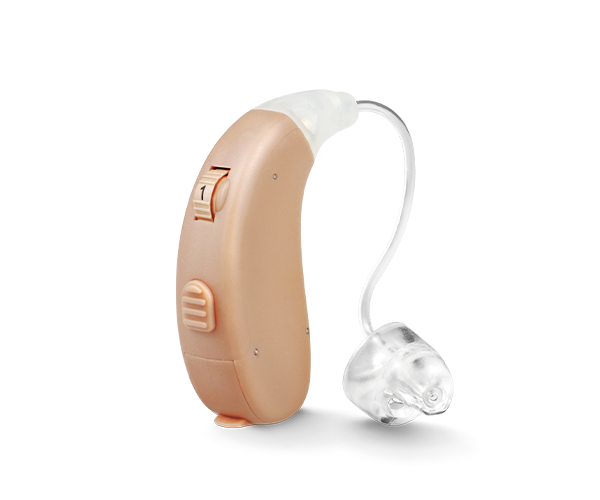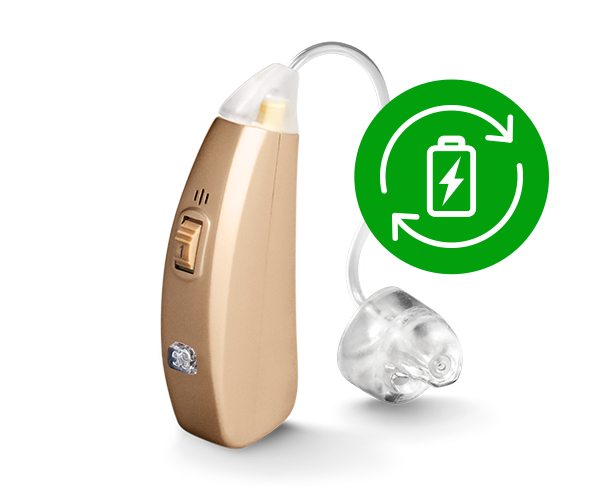“Digital is better,” your audiologist says, “That’s why hearing aid clinics don’t sell analog hearing aids anymore.” But why? Why is digital better than analog? And should you really pay thousands of dollars more for digital technology?
To understand the “why” behind digital hearing aids, we need to look under the hood, and carefully compare the differences between the features of digital and analog devices. So get your tweezers out! We’re going to peek inside what makes a modern hearing aid tick.
Plus, we’re going to tell you how to save thousands on cutting-edge digital hearing aids, so stay tuned…
What Makes a Digital Hearing Aid Special?
Every hearing aid includes four principal components:
- A microphone: The part that picks up the sound.
- An amplifier: That part that makes the sound louder.
- A receiver: The “little speaker” that creates the sound you hear.
- A battery: The part that powers your hearing aid.
The main difference between digital hearing aids and analog hearing aids lies in the amplifier:
- Analog amplifiers: Analog amplifiers are simple. They increase the volume of specific sound frequencies and that’s about it – usually, they focus on the higher frequencies between 2,000 to 8,000 Hz where the most hearing loss occurs.
- Digital amplifiers: Digital amplifiers are nuanced and sophisticated. They are tiny but powerful computers that convert sound waves into digital code. From there, they analyze and change the code in sophisticated ways before sending it to your ears. Digital amplifiers can clear out background noise, reduce feedback, zoom in on the sounds and voices you need to hear, and more. The result is the clearest hearing possible in the widest variety of listening environments.
The other thing that makes digital hearing aids special is the price tag. Digital hearing aid technology tends to cost thousands more than analog tech. In the next section, we’re going to look at the advantages that come with these higher prices, so you can decide whether a digital hearing aid is worth the investment.
Comparing Digital Hearing Aids vs. Analog Hearing Aids
Let’s compare the features of digital hearing aids vs. analog hearing aids:
1. Feedback Cancellation and Feedback Management
Hearing aids create whistling noises because of feedback. Feedback happens when the hearing aid microphone picks up sound from the receiver, amplifies it, sends it back to the receiver, and repeats the process in a “feedback loop” that causes a high-pitched squealing sound.
- Analog hearing aid feedback management: Analog hearing aids manage feedback noise by completely sealing the ear tip within the ear – so the microphone can’t pick up the receiver sounds. But this method isn’t perfect. If the hearing aid is on when you put the ear tip in your ear, you’ll hear the squealing noise before inserting the tip. Also, if the tip moves position or the seal isn’t perfect, you’ll hear the whistling sound again.
- Digital hearing aid feedback cancellation: Digital hearing aids often include advanced feedback cancellation technology. These features stop the feedback loop in its tracks. By detecting and removing the whistling noises before they get to your ears, digital hearing aids are far less likely to produce feedback squeals, even when the seal on your ear tip isn’t perfectly tight.
2. Microphones
Hearing aids can include two different types of microphones: directional and omnidirectional. Some feature one or the other, while others feature both. Directional microphones pick up sounds from the front-facing direction for clearer conversations in noisy environments. Omnidirectional mics pick up sounds from all directions for broader listening in quiet areas.
- Analog hearing aid microphones: Most analog hearing aids have either a single omnidirectional microphone or a single directional microphone. Some feature both, and users can manually switch from omnidirectional to directional depending on their listening environment. Be sure to check what kind of microphone your analog hearing aid includes so you know whether it’s optimized for listening in noise or listening in quiet environments.
- Digital hearing aid microphones: Many digital hearing aids – such as the MDHearing VOLT – feature both an omnidirectional and directional microphone with a button to select between the two or more programs. More advanced digital hearing aids – like the MDHearing CORE – monitor the background noise conditions around you and automatically balance the use of omnidirectional and directional microphones for the clearest listening experience.
3. Noise Filtering Technology
Many hearing aids include advanced noise filtering technology to clarify the most important sounds in complex listening situations – such as restaurants, bars, churches, and other places where hearing conversations is challenging. Noise management technology also filters out disorienting background noise from appliances, air conditioners, dishwashers, airplanes, traffic, or lawn equipment.
- Analog hearing aid noise filtering: Analog hearing aids don’t include any features for noise filtering or noise management. They pick up sounds – or specific sound frequencies – without being able to discriminate, filter out, or clarify the sounds you want to hear from the sounds you don’t. Any “filtering” with an analog hearing aid occurs by amplifying specific frequency ranges. This is why analog hearing aids may not perform as well as you want them to in a noisy restaurant, and they’ll perform best in quieter, at-home listening environments.
- Digital hearing aid noise filtering: It’s the noise filtering capabilities of digital hearing aid technology that really sets digital hearing aids apart from their analog counterparts. The sound processor in digital hearing aids can sense the difference between longer-term power signals, such as unwanted background noise, and fast-acting signals, such as speech which are key to distinguishing between the sounds that are important for you to hear and the sounds that are just confusing background noise. This is valuable when you’re having a conversation in a noisy place. The digital hearing aid will highlight and clarify the sounds of the voices that are close to you while diminishing other distractions.
4. Music Listening
The difference between listening to music with analog hearing aids vs. digital hearing aids is a bit like listening to an MP3 or CD versus a cassette tape or record player. One is digitized, the other is analog, and both offer distinct advantages.
- Analog hearing aid music listening: Live musicians with hearing loss have long-preferred analog hearing aids because they don’t manipulate the purity of the original sound. Instead, they amplify sounds as they are. For non-musicians, the difference in sound might not be very noticeable – especially when you’re listening to digitized music from a CD, TV, MP3 player, or smartphone.
- Digital hearing aid music listening: Many digital hearing aids feature Bluetooth connectivity, which is a clear advantage over analog hearing aids for music listening. Instead of picking up music from the airwaves around you, Bluetooth connects the hearing aid to a music source directly, to stream high-quality digital sound into your ears without interference.
5. Connectivity
Some hearing aids can connect to a hearing aid app on your smartphone to easily control and change the settings on your hearing aid. Some can also connect to smart TVs, telephones, and MP3 players. Let’s look at how analog and digital hearing aids differ regarding these connectivity options.
- Analog hearing aid connectivity: Many analog hearing aids have the ability to pick up sound signals from a telephone through a “telecoil.” Telecoils are small copper wires inside the hearing aid that receive electromagnetic sound signals from your phone and transmit them through your hearing aid as sound into your ear.
- Digital hearing aid connectivity: Some advanced digital hearing aids – like the MDHearing CORE – connect to an app on your smartphone through wireless Bluetooth technology. This lets you change the settings on your hearing aids with the smartphone app. The smartphone app connectivity of the MDHearing CORE is particularly exciting because it empowers users to fine-tune the settings on their hearing aids at home without needing to visit a hearing aid clinic. Some digital hearing aids also allow you to stream music, sound, and voice calls through a Bluetooth connection.
How to Buy an Affordable, High-Quality Digital Hearing Aid You Can Trust
At the beginning of this article, we promised to tell you about buying an affordable digital hearing aid. At MDHearing, our high-quality, FDA-registered digital hearing aids are thousands of dollars less than comparable brands. Priced between $399.99 and $1,199.99 per pair – MDHearings also come with a 100% money-back guarantee, so there’s no risk in giving them a try.
MDHearing offers three digital hearing aid models:
MDHearing AIR: At a price of just $399.99 per pair (with our buy-one-get-one-free offer), the AIR is America’s best selling value digital hearing aid. The AIR’s advanced digital technology includes feedback cancellation and a program button to cycle between four different listening environments (quiet, social, noisy, and restaurant) so you can experience clear listening regardless of the background sound conditions.
MDHearing VOLT: At a price of just $599.99 per pair (with our buy-one-get-one-free offer), the VOLT includes intelligent directional microphones, feedback cancellation, and advanced noise management technology that automatically clarifies the sounds you need to hear in different listening situations. The VOLT is also rechargeable so you’ll never have to change a tiny battery again.
MDHearing CORE: At a price of just $1,199.99 (see the offer here), the CORE features intelligent directional microphones, feedback cancellation, and high-tech noise management technology – similar to the VOLT – which clarifies the most important sounds you want to focus on in different listening environments. The CORE also features Bluetooth connectivity and a smartphone app so you can customize and fine-tune the adjustments on your hearing aid from a smartphone or tablet.
Read more about hearing aid prices and MDHearing’s goal of disrupting the hearing aid industry with affordable, high-quality digital hearing aid solutions in this article: The Cost of Hearing Aids.
Want to see if MDHearing hearing aids will work for you? Take our quick and easy online hearing test and get your results instantly.
TAKE ONLINE HEARING TEST
Learn more about MDHearing's user-adjustable digital hearing aids.
VIEW DIGITAL HEARING AIDS





